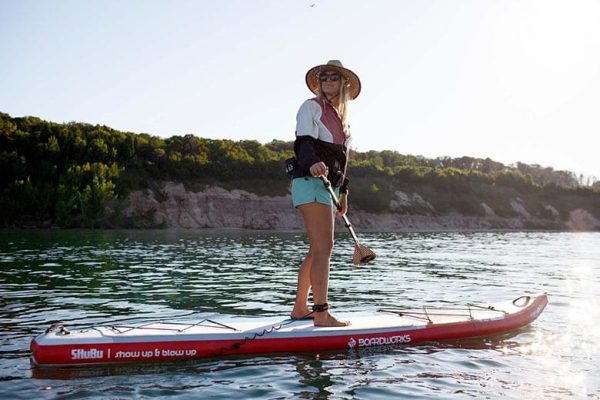We’re here to shed some light on the potential downsides of owning an inflatable stand-up paddle board.
While these versatile boards have gained popularity for their portability and ease of use, it’s essential to consider the drawbacks before diving into paddleboarding.
From concerns about durability and stability to the limitations of performance in rough waters, we’ll uncover the cons that might make you think twice before opting for an inflatable stand-up paddle board.
This image is the property of isupworld.com.
Durability
Vulnerability to punctures
One of the main concerns with inflatable stand-up paddle boards (SUPs) is their vulnerability to punctures. Unlike solid boards, made of sturdy materials, inflatable SUPs are made of a flexible and relatively thinner material that is more prone to punctures. A simple accident such as hitting a sharp object or scraping against rocks could cause a puncture in the inflatable board, rendering it unusable until repaired.
Lower resistance to impact
Another aspect of durability that may be a concern for some users is the lower resistance to the impact of inflatable SUPs compared to their solid counterparts. While solid boards are designed to withstand substantial impacts and even handle rough surfing conditions, inflatable SUPs may not hold up. A heavy impact or collision with a hard surface could potentially cause damage to the inflatable board, compromising its structural integrity.
Potential for delamination
Delamination refers to the separation of layers within a paddle board, and it is a potential issue that can occur in inflatable SUPs. Over time and regular use, the adhesive that holds the layers of the inflatable board together may weaken or deteriorate, leading to delamination. This can result in a loss of structural integrity and performance of the board, requiring repairs or replacement.
Stability
Less rigid than solid boards
One of the trade-offs with inflatable SUPs is that they are generally less rigid than solid boards. While advancements in technology have made inflatable SUPs increasingly more rigid, they still cannot match the stiffness of solid boards. This reduced rigidity can impact stability, especially in choppy or rough water conditions.
Difficulty in windy conditions
Due to their flexible nature, inflatable SUPs may pose challenges in windy conditions. The lack of rigidity can make it harder to maintain a straight and steady course, particularly when facing solid wind gusts. This can affect the paddling experience and make it more challenging to control the board.
Reduced stability for larger riders
Another stability aspect to consider with inflatable SUPs is the reduced stability for larger riders. The lower rigidity of the board, combined with the weight and size of a larger rider, may impact stability on the water. More prominent individuals need to consider the weight capacity and dimensions of the inflatable board to ensure a stable and enjoyable paddleboarding experience.
Performance
Slower speed compared to solid boards
Inflatable SUPs generally offer slightly slower speeds compared to solid boards. The flexibility of the inflatable material can cause some drag in the water, leading to a reduction in speed. While this may not be a significant concern for casual or recreational paddlers, those seeking faster speeds for racing or long-distance paddling may find inflatable SUPs less suitable.
Less responsive maneuverability
Another performance aspect that may be affected by inflatable SUPs is maneuverability. The board’s flexibility can make it less responsive to quick turns or precise maneuvers than solid boards. This can be a consideration for those who enjoy challenging themselves with advanced paddleboarding techniques or participate in competitions requiring nimble maneuverability.
Limited wave performance
For those who enjoy surfing, inflatable SUPs may have some limitations in wave performance. The reduced rigidity and flexibility of the board can make it more challenging to handle more giant waves or perform advanced maneuvers. Solid boards are generally better suited for wave riding due to increased stability and rigidity.
Storage and Transportation
Requires more space to store
One factor to consider when opting for an inflatable SUP is the required storage space. Unlike solid boards that can be stored upright or hanging on a wall, inflatable SUPs must be deflated and rolled up for storage. This means a larger area is needed to store the deflated board, mainly if you have limited storage space.
Additional time needed for inflation and deflation
Another aspect to remember is the additional time needed for the inflation and deflation of an inflatable SUP. Before each paddling session, the board must be inflated to the recommended PSI (pounds per square inch), which can take several minutes, depending on the pump used. After paddling, the board must be deflated and rolled up properly for storage. This process adds extra time to your overall paddleboarding experience.
Possibility of losing or misplacing parts
With inflatable SUPs, the possibility of losing or misplacing essential parts such as the pump, fin, or repair kit is always possible. These components are crucial for the proper functioning and maintenance of the board. Ensuring that all parts are securely stored and accounted for is essential to avoid inconveniences or delays when preparing for a paddleboarding session.
This image is the property of www.supboardguide.com.
Maintenance
Regular inspection for damage
Regular inspections for damage are necessary to ensure the longevity and optimal performance of an inflatable SUP. This includes thoroughly checking for any punctures, delamination, or damage to the valve system. By regularly inspecting the board, any issues can be identified early on and promptly addressed to prevent further damage and potential safety concerns.
Necessary repairs for punctures
In the event of a puncture, immediate repairs are essential to restore the integrity of the inflatable SUP. Depending on the severity of the puncture, repairs may range from simple patching with repair adhesive to more extensive procedures. It is essential to follow the manufacturer’s instructions for proper repair techniques or seek professional assistance.
Issues with valve function
The valve system of an inflatable SUP is critical for inflation and deflation. However, it is not uncommon to encounter issues with valve function over time. This may include difficulties adequately sealing the valve or air leakage during inflation. Regular maintenance and cleaning of the valve system are necessary to ensure its proper function and to prevent any air leakage or pressure loss.
Inflation
Dependency on a pump or manual effort
Inflating an inflatable SUP requires manual effort with a hand or electric pump. This dependency on a pump can be inconvenient, especially without a working pump or any nearby power source. A reliable pump or alternative inflation method is crucial to ensure a hassle-free and timely setup of the inflatable board.
Difficulty achieving optimal PSI
Inflatable SUPs come with a recommended PSI, which determines the board’s rigidity and performance on the water. Achieving the optimal PSI can sometimes be challenging, as it requires careful monitoring and adjustment during inflation. Underinflated boards may lack stability, while overinflated boards can become too rigid and potentially prone to damage. Consistently achieving the optimal PSI may take some practice and patience.
Potential for air leakage
Air leakage is another concern with inflatable SUPs. Over time, the board may develop small leaks that result in a gradual loss of air pressure. This can impact the board’s overall performance and stability on the water. Regular inspections and maintenance, including checking for air leakage, are essential to prevent any unexpected deflation during your paddleboarding adventures.
This image is the property of blog.lakefrontliving.com.
Temperature
Susceptibility to expanding or contracting in extreme temperatures
Inflatable SUPs are susceptible to expanding or contracting in extreme temperature conditions. High temperatures can cause the material to expand, potentially affecting the board’s shape and rigidity. On the other hand, cold temperatures can cause the material to contract, making the board feel less stable and potentially more prone to damage. It is essential to consider these temperature considerations when using and storing an inflatable SUP.
Risk of damage in hot environments
Exposing an inflatable SUP to prolonged periods of intense heat, such as leaving it inside a hot car or under direct sunlight, can pose a risk of damage. The heat can cause the material to become more vulnerable to punctures, delamination, and other structural issues. Storing and transporting the board is essential to minimize exposure to extreme heat.
Reduced performance in cold conditions
Cold weather can also impact the performance of an inflatable SUP. The decrease in temperature can make the material feel stiffer and less flexible, potentially affecting the board’s overall performance on the water. Be mindful of these temperature effects and adjust your expectations when paddleboarding in colder climates.
Cost
Higher initial investment compared to some solid boards
Unlike solid boards, inflatable SUPs generally come with a higher initial investment. The cost of the board and the necessary accessories, such as a pump, paddle, and leash, can add up. It is crucial to carefully consider your budget and priorities when deciding on the type of paddleboard that best suits your needs.
Need for additional accessories.
Inflatable SUPs often require additional accessories that may not be included with the board. This can include a pump, paddle, leash, and storage bag. These accessories are essential for proper usage and maintenance, and not having them readily available can hinder your paddleboarding experience. It is essential to factor in the cost of these additional accessories when considering the overall investment of an inflatable SUP.
The expense of repairs and maintenance
Ongoing repairs and maintenance can also add to the overall cost of owning an inflatable SUP. Repair costs can accumulate over time in the event of damage, punctures, or necessary replacements of parts. Additionally, regular maintenance supplies such as cleaning agents, adhesive patches, and valve maintenance kits may need to be purchased. Budgeting these additional expenses is essential to care for your inflatable SUP adequately.
This image is the property of images. Surfers. Art.
Aesthetics
Appearance may be less visually appealing than solid boards.
Regarding aesthetics, inflatable SUPs may not be as visually appealing as solid boards to some people. The flexible nature of the inflatable material may result in a slightly wrinkled or less polished appearance compared to the smooth finish of solid boards. While this may be a matter of personal preference, it is worth considering if the appearance of your paddleboard is a significant factor in your decision-making process.
Limited design options
Inflatable SUPs generally offer limited design options compared to solid boards. The nature of the inflatable material may restrict intricate designs or patterns that can be achieved. While some manufacturers offer a variety of colors and basic designs, the limited options may not cater to those seeking more vibrant or customized paddleboard aesthetics.
Environmental Impact
Potential release of harmful materials
One environmental concern with inflatable SUPs is the potential release of harmful materials into the environment. The manufacturing and disposal processes of inflatable SUPs may involve the use of chemicals or materials that are not environmentally friendly. Choosing brands that prioritize sustainable and eco-friendly practices is essential to minimize the negative impact on the environment.
Difficulty in recycling
Disposing of an inflatable SUP can pose challenges in terms of recycling. Unlike solid boards that can be recycled or repurposed, inflatable SUPs typically consist of multiple materials, including plastics and fabrics, which may be difficult to separate for recycling purposes. It is important to explore alternative disposal methods or consider donating the board to someone who can use it to extend its lifespan.
Long-term effects on marine life
In the event of damage or loss of an inflatable SUP, there is a risk of it ending up in water bodies where it can have long-term effects on marine life.
The materials used in inflatable SUPs can threaten aquatic ecosystems, potentially harming marine animals and negatively impacting their habitats. It is crucial to properly secure and dispose of inflatable SUPs to prevent any accidental damage to the environment.
In conclusion, inflatable stand-up paddle boards offer convenience and portability, but they have specific cons that must be considered.
There are trade-offs to be aware of, from durability concerns such as vulnerability to punctures and delamination to stability issues in windy conditions and reduced performance compared to solid boards. Factors such as the need for extra storage space, time required for inflation and deflation, and the potential for maintenance and repair expenses should also be considered.
Environmental impact is another aspect to consider, including the potential release of harmful materials and difficulty recycling the boards. By carefully weighing the pros and cons, individuals can decide whether an inflatable SUP suits their paddleboarding needs.
This image is the property of www.switchbacktravel.com.










































